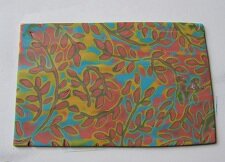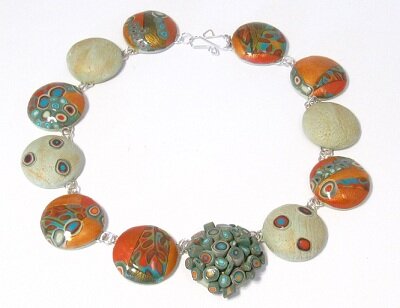|
Contact the seller in advance before paying for the order! Golden Polymer Clay Beads
In this Polymer clay tutorial you will use different techniques, like Mokume Gane, texture impression, making logs with a clay gun and embellishment. You will create these gorgeous golden beads by baking them on a paint palette and then fill them. Sound complicated? It really isn't. Just take a look: You will need the following:
Are you ready? OK! Let's start: 
Yellow: ½ part Lavender + 2 parts sunflower Condition each color well and run them through a medium setting on your pasta machine. Cut each sheet in three parts, two of equal size and one smaller. Put the smallest aside. 
Apply acrylic gold paint to one of the large sheets of all colors but the blue, and put them aside to dry.

Make the Mokume Gane sheet: Dust the polymer clay with cornstarch and stamp an impression onto the clay with the texture sheet.

Use a soft tissue blade and start shaving off thin layers of the print. Your goal is to cut away until there are no impressions left and the sheet is smooth. You will not use the shavings, but the sheet in this project. When done, put a sheet of paper on top, and roll over it with your acrylic roller. Put it aside. 
Make logs with the clay gun:

Make the patterned sheet: Cut out strips of all the sheets and put them together in a pattern on the scrap clay. When it is covered, cut slices of the logs you made, and apply them where you want them. When done, smooth the surface either with the acrylic roller, or by using the back of a spoon.

Make the beads: Stamp the remaining piece of the light green sheet with rough sand paper. Use the shape cutter to cut out the beads, and apply them to the paint palette as well. Cut slices of the logs and embellish 2 or 3 of the light green beads. 
Smooth the edges around each bead, so that you cannot see the scrap clay.

Make the “sky scraper” bead: Bake the beads for 30 minutes, and leave them to cool off. 
Put the beads on a ceramic tile. Use soft brush and apply liquid polymer clay in a thin layer on one of them. Hold it with a pair of tweezers and heat it with the heat gun, until the clay has set and turned frosty. Move it with the tweezers the whole time so that the liquid polymer clay won't run off. Put it down on the tile and continue heating it until it has a silky sheen. If you continue holding it with the tweezers, it will be damaged by it, since the clay becomes soft when heated.

Repeat with all the beads. Put on 2-3 layers. Let them cool completely and then reheat them until they are shiny. If you want to know more about glazing beads with liquid clay, click here 
Glaze the embellished beads:

Fill the beads: Mix some more light green clay, if you don't have any left. Condition it well, and roll it through on the thickest setting. Do the same with some scrap clay. You will use this clay to fill the beads, so don't worry about the color.

Use the large shape cutter and cut out shapes of both clays. Mix two pieces of the scrap clay into a small ball, and put it into one of the beads. To have it stick, it may be wise to apply some liquid clay onto the inside of the beads, so that it will bond when re-baked. Make sure you expel all the air. Flatten it with your fingers and then use the tissue blade to slice of the clay that protrudes above the edges of the bead.

Add jump rings, one on each side. You must put them higher than the middle to prevent the beads to turning around when you wear them. 
Then put a light green piece on top, if it is to large, use a craft knife to cut it to the right size. This will be the back-side of the bead. Repeat with all the beads. Put them on a piece of paper and bake them for 45 minutes. When cooled off, sand the edges and the bottom, and your are done. All you have to do now, is to put the beads together into a necklace. You do this by adding jump rings to attach the beads to each other and then add a clasp. If you like the wire clasp in the photo of the finnished jewelry, you can see how it is made here. Return from Golden Polymer Clay Beads to Polymer Clay Tutorials Leave a comment ,I would love to hear your opinion on this page. Good or bad, it will help me making this Site better. Comments from other visitorsClick below to see contributions from other visitors to this page... Gorgeous beads - question re fern texture. Paint Palletes - what material? Thank you for sharing so generously! |



